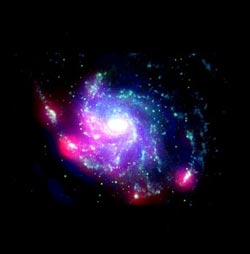Akari’s observations of galaxy M101

This is a composite image of the spiral galaxy M101. The image shows the distribution of cold (blue) and warm (red) dust overlaid on the visible (green, showing distribution of stars) and far-ultraviolet (cyan, indicating the location of young stars) images of M101. Credits: Composite: JAXA, visible (green): the National Geographic Society, far-ultraviolet (cyan): GALEX/NASA
Toyoaki Suzuki at the University of Tokyo conducted observations of M101 with AKARI at four infrared wavelengths (65, 90, 140, and 160 micrometres) using the Far-Infrared Surveyor (FIS) instrument.
Many young high-temperature stars populate the spiral arms, revealing the areas of star formation and warming the interstellar dust. This causes the galaxy to shine at shorter infrared wavelengths. In contrast, the longer wavelengths show where the ‘cold’ dust is located. Normal stars, typically like our own Sun, warm this dust.
FIS data was compared to an image of M101 in the visible and far-ultraviolet. It shows that warm dust is distributed along the spiral arms, with many hot spots located along the outer edge of the galaxy. These spots correspond to giant star-forming regions. This is unusual because star formation is generally more active in the central parts of spiral galaxies.
The evidence points to M101 having experienced a close encounter with a companion galaxy in the past, dragging out gas from the hapless companion. The gas is now falling onto the outer edge of M101 at approximately 150 km/s, triggering the active star formation.
Media Contact
More Information:
http://www.esa.int/esaSC/SEMYRSMPQ5F_index_0.htmlAll latest news from the category: Physics and Astronomy
This area deals with the fundamental laws and building blocks of nature and how they interact, the properties and the behavior of matter, and research into space and time and their structures.
innovations-report provides in-depth reports and articles on subjects such as astrophysics, laser technologies, nuclear, quantum, particle and solid-state physics, nanotechnologies, planetary research and findings (Mars, Venus) and developments related to the Hubble Telescope.
Newest articles

Silicon Carbide Innovation Alliance to drive industrial-scale semiconductor work
Known for its ability to withstand extreme environments and high voltages, silicon carbide (SiC) is a semiconducting material made up of silicon and carbon atoms arranged into crystals that is…

New SPECT/CT technique shows impressive biomarker identification
…offers increased access for prostate cancer patients. A novel SPECT/CT acquisition method can accurately detect radiopharmaceutical biodistribution in a convenient manner for prostate cancer patients, opening the door for more…

How 3D printers can give robots a soft touch
Soft skin coverings and touch sensors have emerged as a promising feature for robots that are both safer and more intuitive for human interaction, but they are expensive and difficult…





















